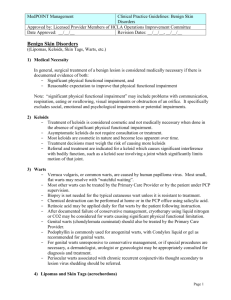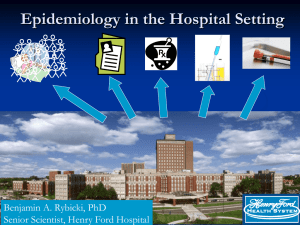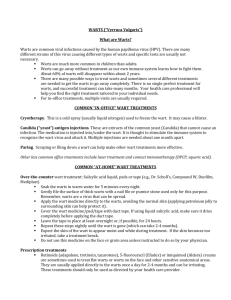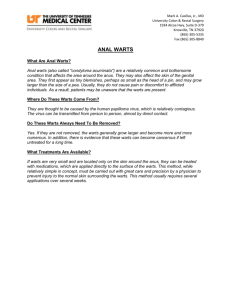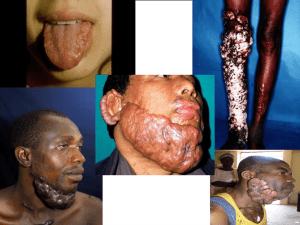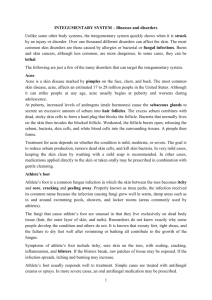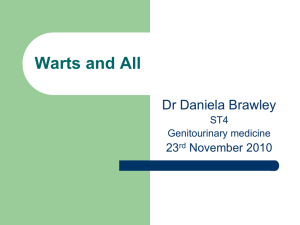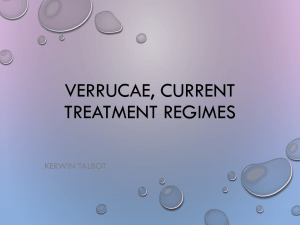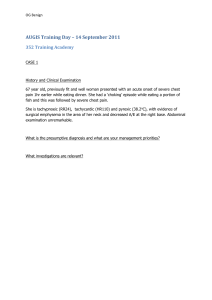Benign Skin Disorders
advertisement
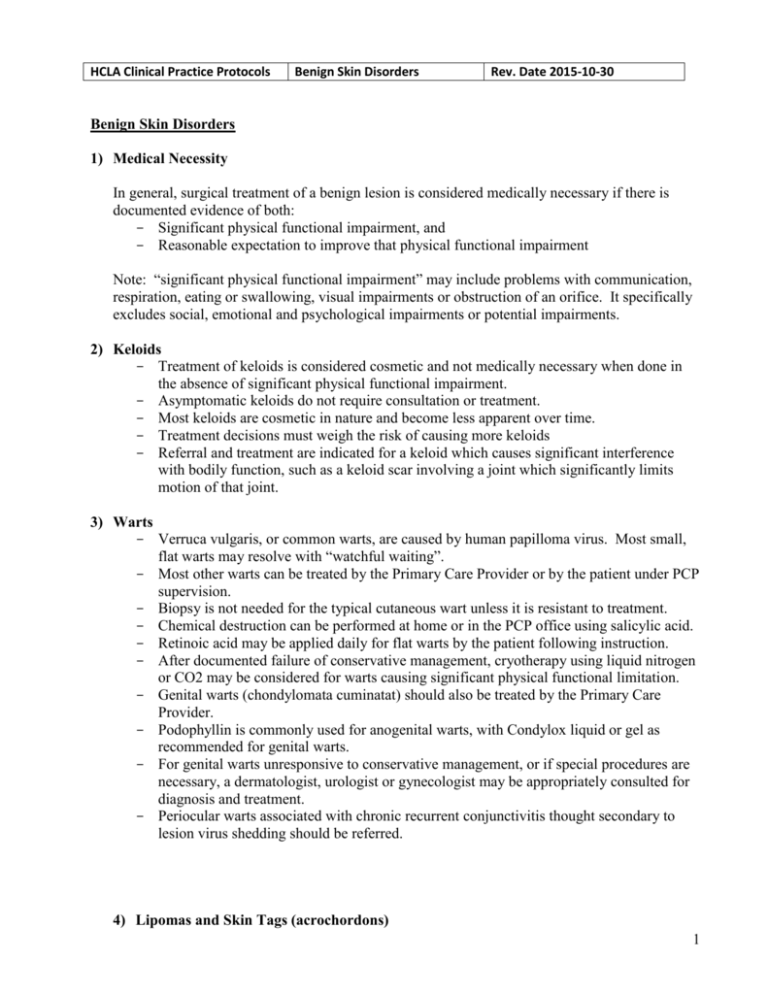
HCLA Clinical Practice Protocols Benign Skin Disorders Rev. Date 2015-10-30 Benign Skin Disorders 1) Medical Necessity In general, surgical treatment of a benign lesion is considered medically necessary if there is documented evidence of both: - Significant physical functional impairment, and - Reasonable expectation to improve that physical functional impairment Note: “significant physical functional impairment” may include problems with communication, respiration, eating or swallowing, visual impairments or obstruction of an orifice. It specifically excludes social, emotional and psychological impairments or potential impairments. 2) Keloids - Treatment of keloids is considered cosmetic and not medically necessary when done in the absence of significant physical functional impairment. - Asymptomatic keloids do not require consultation or treatment. - Most keloids are cosmetic in nature and become less apparent over time. - Treatment decisions must weigh the risk of causing more keloids - Referral and treatment are indicated for a keloid which causes significant interference with bodily function, such as a keloid scar involving a joint which significantly limits motion of that joint. 3) Warts - Verruca vulgaris, or common warts, are caused by human papilloma virus. Most small, flat warts may resolve with “watchful waiting”. - Most other warts can be treated by the Primary Care Provider or by the patient under PCP supervision. - Biopsy is not needed for the typical cutaneous wart unless it is resistant to treatment. - Chemical destruction can be performed at home or in the PCP office using salicylic acid. - Retinoic acid may be applied daily for flat warts by the patient following instruction. - After documented failure of conservative management, cryotherapy using liquid nitrogen or CO2 may be considered for warts causing significant physical functional limitation. - Genital warts (chondylomata cuminatat) should also be treated by the Primary Care Provider. - Podophyllin is commonly used for anogenital warts, with Condylox liquid or gel as recommended for genital warts. - For genital warts unresponsive to conservative management, or if special procedures are necessary, a dermatologist, urologist or gynecologist may be appropriately consulted for diagnosis and treatment. - Periocular warts associated with chronic recurrent conjunctivitis thought secondary to lesion virus shedding should be referred. 4) Lipomas and Skin Tags (acrochordons) 1 HCLA Clinical Practice Protocols Benign Skin Disorders Rev. Date 2015-10-30 - Treatment of lipomas and skin tags (acrochordons) is considered cosmetic and not medically necessary when done in the absence of significant physical functional impairment. Such functional impairments may include problems with communication, respiration, eating, swallowing, visual impairments or obstruction of an orifice. 5) Indications for Referral or Excision, as Medically Necessary - Any lesion clinically suspicious for malignancy (e.g., atypical dysplastic nevi, probably basal or squamous cell cancer) or that has a known tendency for malignant change to occur. These lesions are usually referred to a dermatologist for biopsy and treatment recommendations. [Precancerous and cancerous skin lesions require follow-up surveillance by the primary physician and/or consultant for detection of metastases or recurrence at the same or other sites.] - Large numbers of nevi - Personal or family history of melanoma. - A presumably benign lesion that Grows or enlarges; exhibits spotty color changes and/or irregular margins; Begins to bleed or ulcerate; NOTE: Most benign skin disorders require no diagnostic evaluation or treatment other than clinical observation and reassurance. However, patients frequently seek removal of lesions that are presumably benign on the basis of history and examination or confirmed as benign by biopsy. Removal of such benign lesions at the patient’s request when not meeting established criteria of medical necessity is the patient’s financial responsibility. When there is clinical uncertainty as to the likely diagnosis, particularly where malignancy is a realistic consideration based on history and lesion appearance, surgical removal may be considered medically necessary. Plastic surgery is the surgical specialty that deals with reshaping or remolding of tissue in order to approximate a normal appearance or to repair functional ability lost due to disease, congenital defect, or trauma. According to the American Society of Plastic and Reconstructive Surgeons, the specialty of plastic surgery includes two types of procedures: 1) reconstructive surgery performed on abnormal structures caused by congenital defects, developmental abnormalities, trauma, infection, tumors, involutional defects, or disease and generally performed to improve function; and 2) cosmetic surgery performed to improve the patient’s appearance and self-esteem. Some benign skin lesions for which cosmetic surgery is commonly sought are lipomas, keloid and surgical scars, skin tags, seborrheic keratoses and warts. The doctrine of “significant physical functional impairment” should be applied to determine medical necessity for these services. References: Apollo Managed Care Consultants, “Medical Review Criteria Guidelines for Managing Care”, Eighth Edition, pp 142, 174-175, 181. 2 HCLA Clinical Practice Protocols Benign Skin Disorders Rev. Date 2015-10-30 Anthem Medical Policy “Cosmetic and Reconstructive Services: Skin Related”, Policy #ANC.00007, updated 10/1/10. Health Net Medical Policy “Cosmetic and Reconstructive Surgery”, Policy #NMP169, updated June 2009. 3
